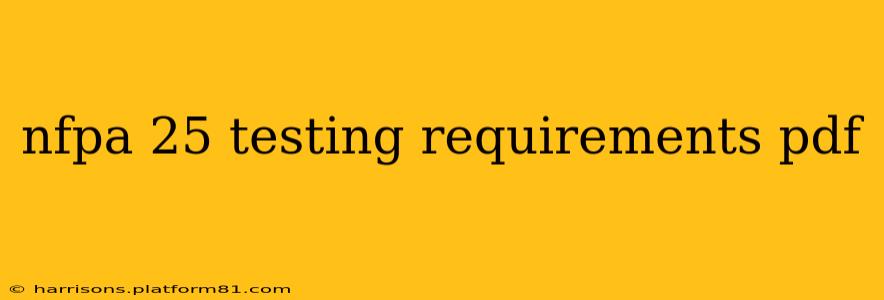NFPA 25, Standard for the Inspection, Testing, and Maintenance of Water-Based Fire Protection Systems, is a crucial document for ensuring the reliability of fire sprinkler systems. This standard outlines rigorous testing requirements to guarantee these systems are ready to perform their life-saving function when needed. Finding a readily available PDF of NFPA 25 itself requires purchasing it directly from the NFPA. However, this guide will break down the key testing requirements to provide a clear understanding of what's involved.
Understanding NFPA 25's Testing Scope:
NFPA 25 covers a wide range of water-based fire protection systems, including:
- Fire sprinkler systems: This is the primary focus of the standard, encompassing wet-pipe, dry-pipe, deluge, preaction, and water spray systems.
- Standpipes: These systems provide water for fire fighting by building occupants or fire departments.
- Water tanks: These tanks provide water supply for the systems mentioned above.
- Water pumps: These are essential components ensuring sufficient water pressure.
- Associated control valves and other components: This includes everything from check valves to alarm valves.
Key Testing Requirements outlined in NFPA 25:
The testing frequency varies depending on the system type and component, but NFPA 25 establishes a clear schedule. Remember, this is a summary; always refer to the official NFPA 25 document for the complete and accurate details.
Frequency and Types of Tests:
Annual Tests:
- Visual Inspection: A thorough visual inspection of all components is required annually. This includes checking for corrosion, leaks, damage, obstructions, and proper operation of valves and other components.
- Flow Test (for certain systems): Specific types of sprinkler systems require annual flow tests to verify water flow rates and pressure.
- System Water Supply Test (as applicable): Testing the water supply is essential to ensure sufficient water pressure and volume. This is crucial for systems that rely on a significant water supply.
Five-Year Tests:
- Extended Duration Flow Test: This involves a longer flow test to more rigorously assess the system's capacity. This test is generally more intensive and potentially disruptive than annual flow tests.
What are the specific requirements for testing water flow and pressure?
NFPA 25 details specific requirements for testing water flow and pressure, varying depending on the system type. These tests ensure the system can deliver the necessary water volume and pressure at each sprinkler head or standpipe outlet within the required timeframe. The procedures involve opening specific test outlets and measuring the flow rate and pressure using calibrated testing equipment. Failing to meet the minimum pressure and flow rates could indicate problems within the system, like partial blockages, insufficient water supply, or faulty components.
What are the requirements for testing fire department connections?
Fire department connections (FDCs) are critical for fire department access to the system. NFPA 25 requires annual inspections and testing of FDCs to ensure they are readily accessible, unobstructed, and functioning correctly. This includes visually inspecting the connection, ensuring its proper operation, and possibly conducting a flow test to verify the water supply.
How often should I have a sprinkler system professionally inspected and tested?
While the frequency of some tests can be done annually in-house by a qualified individual, NFPA 25 strongly recommends professional inspection and testing by a qualified and certified contractor at least annually, and more frequently for systems with a greater risk of failure.
What are the consequences of not complying with NFPA 25?
Failure to comply with NFPA 25 can have serious consequences, including:
- Increased insurance premiums: Insurance companies often require compliance with NFPA 25 as a condition for coverage.
- Legal liability: In the event of a fire, non-compliance can lead to legal action if the system fails due to inadequate maintenance.
- Loss of life and property: This is the most significant consequence, as a malfunctioning sprinkler system can significantly hinder fire suppression efforts.
Conclusion:
Compliance with NFPA 25 is not merely a matter of regulatory adherence; it’s about safeguarding lives and property. Understanding the testing requirements and implementing a robust testing and maintenance program is crucial for ensuring the effectiveness of water-based fire protection systems. Remember to consult the official NFPA 25 standard for complete and precise details.
